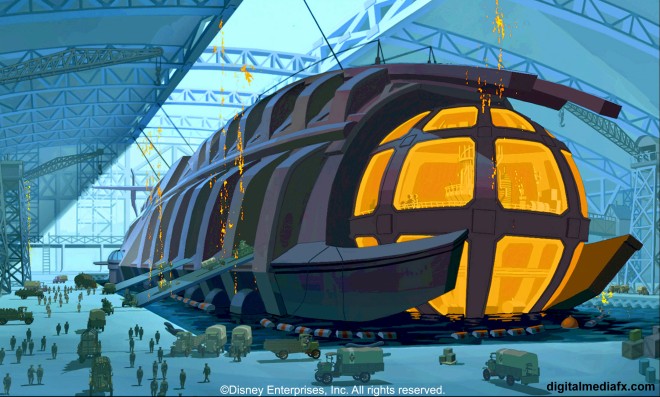Written by Tab Murphy
Directed by Gary Trousdale and Kirk Wise
US, 2001
One of the biggest complaints of animated films in North America is that they are undoubtedly targeted solely at children. While Disney and Pixar may occasionally slip adult jokes in to their films, the films are still marketed to children. On weekends when animated films open, it is assumed that they will be successful because they are targeted at kids going with their families. This is why many flock to the films of Studio Ghibli as examples of animated films for adults. However, shortly after the end of the Disney Renaissance (the films between The Little Mermaid and Tarzan), Disney released their most mature film since The Black Cauldron: Atlantis: The Lost Empire.
The film opens with a quote from Plato about the fall of the continent of Atlantis followed by a cataclysmic scene of its destruction. There, we are introduced to the film’s dark tone (hundreds if not thousands die in this sequence) and the king and princess of Atlantis who we’ll learn more about later on. While this scene seems like just an introduction to the mythology, its context becomes far more important as the story progresses.

When we’re brought to the contemporary setting of the film (1917 New York) we meet the hero of our story, museum employee and Atlantis enthusiast Milo Thatch (voiced by Michael J. Fox). Thatch is preparing to give a presentation to the museum board about a research expedition to find a journal written in Atlantean with cues to find the lost continent. After that separate introduction to the mythology of the film, we get some character development for Milo where we learn that his passion for exploration comes from his grandfather, his job at the museum is particularly unglamorous, and his research is given no respect by his elders.
The film truly gets interesting when Milo returns home after his proposal is rejected. In homage to film noir, we meet a femme fatale who wants to take Milo to her employer. In a fabulously wealthy looking mansion, Milo is introduced to a friend of his grandfather’s who has the journal Milo wanted to find (thanks to an expedition his grandfather had taken shortly before his death) and a lot of money to spend on an expedition to Atlantis once Milo proves his passion is equal to that of his grandfather’s. Then we see some of the greatest animation Disney has ever put to screen: a fantastical submarine with a remarkable steampunk aesthetic. The technology is the most recognizable part of the film’s aesthetic charm, but everything from the character animation (look at their fingers!) to the design of Atlantis itself has this angular look inspired by comic artist Mike Mignola.
The adventure to Atlantis is filled with excellent animation and thrills; the introduction of the diverse cast of characters is another element that separates this film from the children’s fare of the 1990s. With the exception of Moliere (the comic relief), all of the expert crew members (doctor, engineer, demolitions expert, geology, cook, etc) have fully fleshed-out stories and backgrounds. The doctor is a half-black, half-native army doctor who served in the Boer War; the engineer is Latina, grew up in a macho household, and has dreams of making her father (who wanted sons) proud; and the demolitions expert has two loves, flowers and explosions. Even this latter characterization remarkably never feels forced. The full team feels fully developed, and though the film never reflects on the tenuous status of minorities in that era, given Disney’s spotted history with historical accuracy, it’s a positive that the filmmakers created diversity here that feels natural and unstereotypical.
The film gets really deep and thematic once they reach Atlantis and discover the mysterious elemental power source that keeps the continent alive under the earth. We learn that the crystal power source is both a weapon and a battery and then in a speech from the king on his death bed (voiced magnificently by Leanord Nimoy) we learn that Atlantis brought about its own demise when it used that power source as a weapon of war and conquest. This solidifies the film’s primary analogy as a nuclear one and also fixes the claim critics of the film argue: that this is a white saviour narrative. The Atlanteans are in fact closer to a post-nuclear United States, a superpower that destroyed itself and the king is trying to save the Americans from making the same mistake.
The ending is the most poignant set piece, due to its the adult themes. The villain, when stabbed with part of the crystal, literally turns into a crystallized monster. Following the nuclear analogy from earlier, his obsession with this technology corrupts him to his core until he becomes a kind of radioactive monster. This is the depth of Atlantis: The Lost Empire. It takes an adventure story and adds layers of subtext and analogy that would never be accessible to an audience of children. The film was made for a teen-to-adult audience; unfortunately, because of that, it failed at the box office and reinforced Disney’s marketing strategy of making films for a reliably young audience.
Atlantis: The Lost Empire has been relegated along with Dinosaur and Treasure Planet as one of the post-Renaissance failures from Disney. However, unlike those films, Atlantis stands on its own, providing a film with beautiful animation and a high rewatch value due to the depth of character and story.
— Mynt Marsellus


